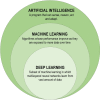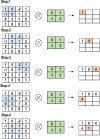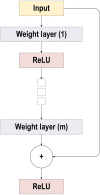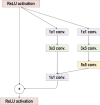Review of deep learning: concepts, CNN architectures, challenges, applications, future directions - PubMed (original) (raw)
Review of deep learning: concepts, CNN architectures, challenges, applications, future directions
Laith Alzubaidi et al. J Big Data. 2021.
Abstract
In the last few years, the deep learning (DL) computing paradigm has been deemed the Gold Standard in the machine learning (ML) community. Moreover, it has gradually become the most widely used computational approach in the field of ML, thus achieving outstanding results on several complex cognitive tasks, matching or even beating those provided by human performance. One of the benefits of DL is the ability to learn massive amounts of data. The DL field has grown fast in the last few years and it has been extensively used to successfully address a wide range of traditional applications. More importantly, DL has outperformed well-known ML techniques in many domains, e.g., cybersecurity, natural language processing, bioinformatics, robotics and control, and medical information processing, among many others. Despite it has been contributed several works reviewing the State-of-the-Art on DL, all of them only tackled one aspect of the DL, which leads to an overall lack of knowledge about it. Therefore, in this contribution, we propose using a more holistic approach in order to provide a more suitable starting point from which to develop a full understanding of DL. Specifically, this review attempts to provide a more comprehensive survey of the most important aspects of DL and including those enhancements recently added to the field. In particular, this paper outlines the importance of DL, presents the types of DL techniques and networks. It then presents convolutional neural networks (CNNs) which the most utilized DL network type and describes the development of CNNs architectures together with their main features, e.g., starting with the AlexNet network and closing with the High-Resolution network (HR.Net). Finally, we further present the challenges and suggested solutions to help researchers understand the existing research gaps. It is followed by a list of the major DL applications. Computational tools including FPGA, GPU, and CPU are summarized along with a description of their influence on DL. The paper ends with the evolution matrix, benchmark datasets, and summary and conclusion.
Keywords: Convolution neural network (CNN); Deep learning; Deep learning applications; Deep neural network architectures; FPGA; GPU; Image classification; Machine learning; Medical image analysis; Supervised learning; Transfer learning.
© The Author(s) 2021.
Conflict of interest statement
Competing interestsThe authors declare that they have no competing interests.
Figures
Fig. 1
Search framework
Fig. 2
Deep learning family
Fig. 3
The difference between deep learning and traditional machine learning
Fig. 4
Deep learning performance compared to human
Fig. 5
An example of RvNN tree
Fig. 6
Typical unfolded RNN diagram
Fig. 7
An example of CNN architecture for image classification
Fig. 8
The primary calculations executed at each step of convolutional layer
Fig. 9
Three types of pooling operations
Fig. 10
Fully connected layer
Fig. 11
Over-fitting and under-fitting issues
Fig. 12
MLP structure
Fig. 13
Neuron activation functions
Fig. 14
The architecture of LeNet
Fig. 15
The architecture of AlexNet
Fig. 16
The architecture of network-in-network
Fig. 17
The architecture of ZefNet
Fig. 18
The architecture of VGG
Fig. 19
The basic structure of Google Block
Fig. 20
The block diagram for ResNet
Fig. 21
The basic block diagram for Inception Residual unit
Fig. 22
The architecture of DenseNet Network (adopted from [112])
Fig. 23
The basic block diagram for the ResNext building blocks
Fig. 24
The basic block diagram for the Xception block architecture
Fig. 25
The complete CapsNet encoding and decoding processes
Fig. 26
The general architecture of HRNet
Fig. 27
The performance of DL regarding the amount of data
Fig. 28
The conceptual diagram of the TL technique
Fig. 29
Examples of DL applications
Fig. 30
Workflow of deep learning tasks
Similar articles
- Survey of Supervised Learning for Medical Image Processing.
Aljuaid A, Anwar M. Aljuaid A, et al. SN Comput Sci. 2022;3(4):292. doi: 10.1007/s42979-022-01166-1. Epub 2022 May 17. SN Comput Sci. 2022. PMID: 35602289 Free PMC article. - Deep convolutional neural networks for mammography: advances, challenges and applications.
Abdelhafiz D, Yang C, Ammar R, Nabavi S. Abdelhafiz D, et al. BMC Bioinformatics. 2019 Jun 6;20(Suppl 11):281. doi: 10.1186/s12859-019-2823-4. BMC Bioinformatics. 2019. PMID: 31167642 Free PMC article. - A Survey on Human Cancer Categorization Based on Deep Learning.
Ibrahim A, Mohamed HK, Maher A, Zhang B. Ibrahim A, et al. Front Artif Intell. 2022 Jun 27;5:884749. doi: 10.3389/frai.2022.884749. eCollection 2022. Front Artif Intell. 2022. PMID: 35832207 Free PMC article. Review. - Hybrid morphological-convolutional neural networks for computer-aided diagnosis.
Canales-Fiscal MR, Tamez-Peña JG. Canales-Fiscal MR, et al. Front Artif Intell. 2023 Sep 19;6:1253183. doi: 10.3389/frai.2023.1253183. eCollection 2023. Front Artif Intell. 2023. PMID: 37795497 Free PMC article. - A Systematic Review and Identification of the Challenges of Deep Learning Techniques for Undersampled Magnetic Resonance Image Reconstruction.
Hossain MB, Shinde RK, Oh S, Kwon KC, Kim N. Hossain MB, et al. Sensors (Basel). 2024 Jan 24;24(3):753. doi: 10.3390/s24030753. Sensors (Basel). 2024. PMID: 38339469 Free PMC article. Review.
Cited by
- Optimizing knee osteoarthritis severity prediction on MRI images using deep stacking ensemble technique.
Panwar P, Chaurasia S, Gangrade J, Bilandi A, Pruthviraja D. Panwar P, et al. Sci Rep. 2024 Nov 5;14(1):26835. doi: 10.1038/s41598-024-78203-x. Sci Rep. 2024. PMID: 39500982 Free PMC article. - Machine learning predictive model for lumbar disc reherniation following microsurgical discectomy.
Mehandzhiyski AG, Yurukov NA, Ilkov PL, Mikova DP, Gabrovsky NS. Mehandzhiyski AG, et al. Brain Spine. 2024 Oct 10;4:103918. doi: 10.1016/j.bas.2024.103918. eCollection 2024. Brain Spine. 2024. PMID: 39493951 Free PMC article. - Predicting deterioration in dengue using a low cost wearable for continuous clinical monitoring.
Ming DK, Daniels J, Chanh HQ, Karolcik S, Hernandez B, Manginas V, Nguyen VH, Nguyen QH, Phan TQ, Luong THT, Trieu HT, Holmes AH, Phan VT, Georgiou P, Yacoub S; VITAL consortium. Ming DK, et al. NPJ Digit Med. 2024 Nov 2;7(1):306. doi: 10.1038/s41746-024-01304-4. NPJ Digit Med. 2024. PMID: 39488652 Free PMC article. - A Multi-label Artificial Intelligence Approach for Improving Breast Cancer Detection With Mammographic Image Analysis.
Park JH, Lim JH, Kim S, Heo J. Park JH, et al. In Vivo. 2024 Nov-Dec;38(6):2864-2872. doi: 10.21873/invivo.13767. In Vivo. 2024. PMID: 39477432 Free PMC article. - A new fusion neural network model and credit card fraud identification.
Jiang S, Liao X, Feng Y, Gao Z, Onasanya BO. Jiang S, et al. PLoS One. 2024 Oct 28;19(10):e0311987. doi: 10.1371/journal.pone.0311987. eCollection 2024. PLoS One. 2024. PMID: 39466806 Free PMC article.
References
- Amrit C, Paauw T, Aly R, Lavric M. Identifying child abuse through text mining and machine learning. Expert Syst Appl. 2017;88:402–418. doi: 10.1016/j.eswa.2017.06.035. - DOI
- Hossain E, Khan I, Un-Noor F, Sikander SS, Sunny MSH. Application of big data and machine learning in smart grid, and associated security concerns: a review. IEEE Access. 2019;7:13960–13988. doi: 10.1109/ACCESS.2019.2894819. - DOI
- Crawford M, Khoshgoftaar TM, Prusa JD, Richter AN, Al Najada H. Survey of review spam detection using machine learning techniques. J Big Data. 2015;2(1):23. doi: 10.1186/s40537-015-0029-9. - DOI
- Deldjoo Y, Elahi M, Cremonesi P, Garzotto F, Piazzolla P, Quadrana M. Content-based video recommendation system based on stylistic visual features. J Data Semant. 2016;5(2):99–113. doi: 10.1007/s13740-016-0060-9. - DOI
LinkOut - more resources
Full Text Sources
Other Literature Sources





























